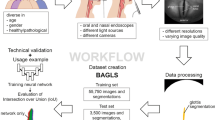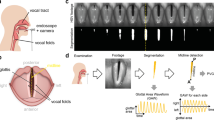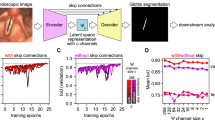Abstract
Accomplishing successful endotracheal intubation (ETI) both rapidly and with a minimum number of attempts is a crucial skill for clinicians in order to manage patient airways and acute care. Repeated attempts may cause airway injury and increase the occurrence of hypoxemia and unstable hemodynamics. Usually, ETI is performed under visualization and recognition of the glottis. Initial success is highly dependent on clinician experience. Most current devices help confirm endotracheal tube position after intubation, but are not useful in reducing unnecessary attempts. This study develops an acoustically guided tracheal intubation system to help ETI providers identify the glottis during the procedure. By insufflating oxygen into the hypopharynx, the acoustic responses of non-glottic structures and the glottis are analyzed using the proposed two-stage segment-based algorithm to recognize the glottis and determine the glottic boundary. The first stage uses a delta Bayesian information criterion with a sliding window process to track potential boundaries with computational efficiency. In the second stage, a Gaussian mixture model classifier with a majority vote filter determines an acoustically evaluated boundary. Performance was assessed by comparing the acoustically evaluated boundary with the actual boundary obtained from synchronized fiberoptic images. Non-glottic and glottic sounds were recorded from 9 anesthetized adults receiving ETI. The success rate of glottic boundary recognition using the proposed method on this dataset is 77.78 %. For the successful cases, corresponding time differences between the acoustically evaluated boundary and the actual boundary were less than 400 ms. This robust method is feasible to help practitioners determine the glottis position rapidly and may reduce unnecessary attempts during ETI.







Similar content being viewed by others
References
Hagberg, C., Georgi, R., & Krier, C. (2005). Complications of managing the airway. Best Practice & Research Clinical Anaesthesiology, 19, 641–659.
Kovac, A. L. (1996). Controlling the hemodynamic response to laryngoscopy and endotracheal intubation. Journal of Clinical Anesthesia, 8, 63–79.
Barak, M., Ziser, A., Greenberg, A., Lischinsky, S., & Rosenberg, B. (2003). Hemodynamic and catecholamine response to tracheal intubation: Direct laryngoscopy compared with fiberoptic intubation. Journal of Clinical Anesthesia, 15, 132–136.
Mort, T. C. (2004). Emergency tracheal intubation: Complications associated with repeated laryngoscopic attempts. Anesthesia and Analgesia, 99, 607–613.
Cooper, R. M., Pacey, J. A., Bishop, M. J., & McCluskey, S. A. (2005). Early clinical experience with a new videolaryngoscope (GlideScope®) in 728 patients. Canadian Journal of Anaesthesia, 52, 191–198.
Walls, R. M., Brown, C. A, III., Bair, A. E., & Pallin, D. J. (2011). Emergency airway management: A multi-center report of 8937 emergency department intubations. Journal of Emergency Medicine, 41, 347–354.
Schwartz, D. E., Matthay, M. A., & Cohen, N. H. (1995). Death and other complications of emergency airway management in critically ill adults: A prospective investigation of 297 tracheal intubations. Anesthesiology, 82, 367–376.
Wang, H. E., & Yealy, D. M. (2006). How many attempts are required to accomplish out-of-hospital endotracheal intubation? Academic Emergency Medicine, 13, 372–377.
Konrad, C., Schupfer, G., Wietlisbach, M., & Gerber, H. (1998). Learning manual skills in anesthesiology: Is there a recommended number of cases for anesthetic procedures? Anesthesia and Analgesia, 86, 635–639.
Wang, H. E., Seitz, S. R., Hostler, D., & Yealy, D. M. (2005). Defining the learning curve for paramedic student endotracheal intubation. Prehosp. Emerg. Care, 9, 156–162.
Sayre, M. R., Sackles, J. C., Mistler, A. F., Evans, J. L., Kramer, A. T., & Pancioli, A. M. (1998). Field trial of endotracheal intubation by basic EMTs. Annals of Emergency Medicine, 31, 228–233.
Sakles, J. C., Mosier, J. M., Chiu, S., & Keim, S. M. (2012). Tracheal intubation in the emergency department: A comparison of GlideScope video laryngoscopy to direct laryngoscopy in 822 intubations. Journal of Emergency Medicine, 42, 400–405.
Liem, E. B., Bjoraker, D. G., & Gravenstein, D. (2003). New options for airway management: Intubating fibreoptic stylets. British Journal of Anaesthesia, 91, 408–418.
Salem, M. R. (2001). Verification of endotracheal tube position. Anesthesiology Clinics of North America, 19, 813–839.
Silvestri, S., Ralls, G. A., Krauss, B., Thundiyil, J., Rothrock, S. G., Senn, A., et al. (2005). The effectiveness of out-of-hospital use of continuous end-tidal carbon dioxide monitoring on the rate of unrecognized misplaced intubation within a regional emergency medical services system. Annals of Emergency Medicine, 45, 497–503.
Lederman, D., Lampotang, S., & Shamir, M. Y. (2011). Automatic endotracheal tube position confirmation system based on image classification: A preliminary assessment. Medical Engineering & Physics, 33, 1017–1026.
Vieira, R. T., Brunet, N., Costa, S. C., Correia, S., Neto, B. G. A., & Fechine, J. M. (2012). Combining entropy measures and cepstral analysis for pathological voice assessment. J. Med. Biol. Eng., 32, 429–436.
Chen, W. H., Chiu, Y. H., Wang, H. C., Hung, Y. W., Su, H. P., & Cheng, K. S. (2014). Tracheal opening discrimination during intubation using acoustic features and Gaussian mixture model. J. Med. Biol. Eng., 34, 605–611.
Hidden Markov Model Toolkit (HTK). (2013). Speech recognition toolkit. Available: http://htk.eng.cam.ac.uk.
Tritschler, A., & Gopinath, R. A. (1999). Improved speaker segmentation and segments clustering using the Bayesian information criterion. Proceedings of the Eurospeech, 99, 679–682.
Gupta, M. R., & Chen, Y. (2011). Theory and use of the EM algorithm. Journal of Foundations and Trends in Signal Processing., 4, 223–296.
Katagiri, S., Juang, B. H., & Lee, C. H. (1998). Pattern recognition using a family of design algorithms based upon the generalized probabilistic descent method. Proceedings of the IEEE, 86, 2345–2373.
Huq, S., & Moussavi, Z. (2012). Acoustic breath-phase detection using tracheal breath sounds. Medical & Biological Engineering & Computing, 50, 297–308.
Acknowledgments
This paper was supported by the Ministry of Science and Technology of Taiwan under grant NSC 102-2221-E-037-003-MY3. The authors would also like to thank all patients and staff for their participation in the study.
Author information
Authors and Affiliations
Corresponding author
Rights and permissions
About this article
Cite this article
Chiu, YH., Chen, WH. & Su, HP. Two-Stage Segment-Based Acoustic Approach for Fast Glottis Identification During Endotracheal Intubation. J. Med. Biol. Eng. 35, 617–625 (2015). https://doi.org/10.1007/s40846-015-0083-y
Received:
Accepted:
Published:
Issue Date:
DOI: https://doi.org/10.1007/s40846-015-0083-y




